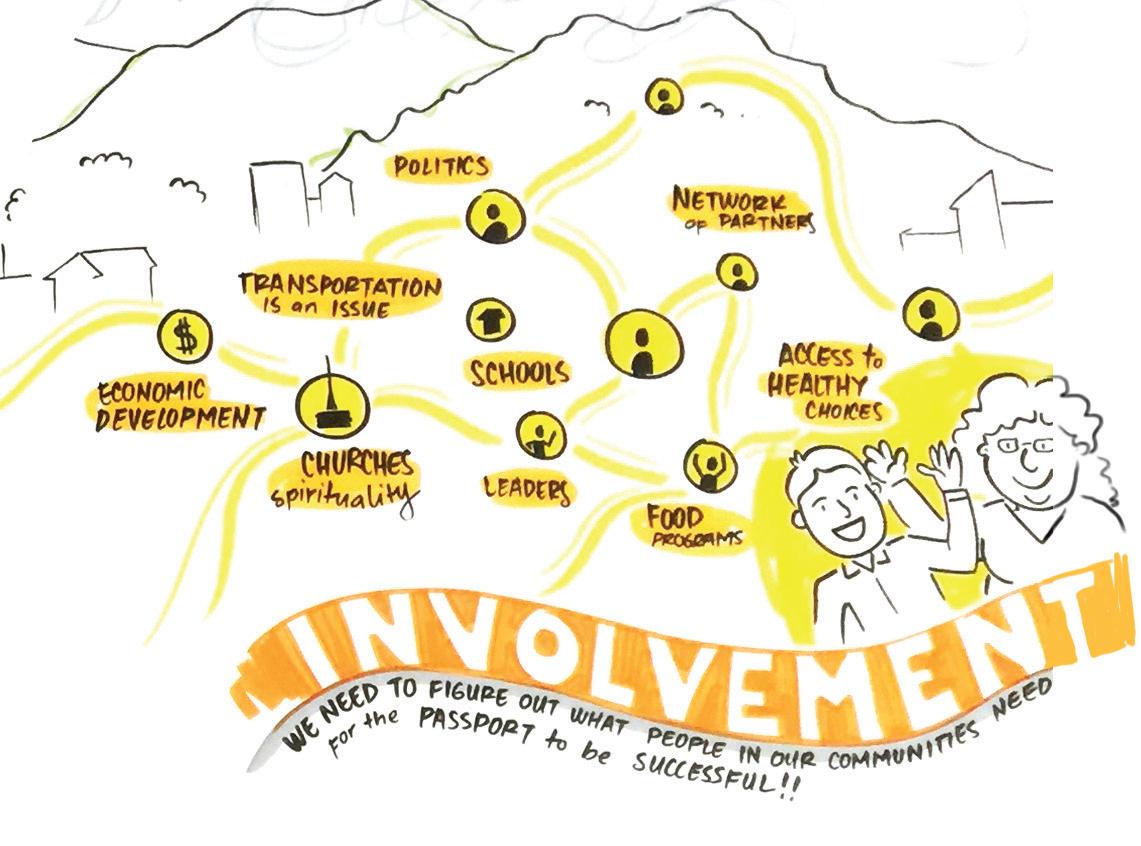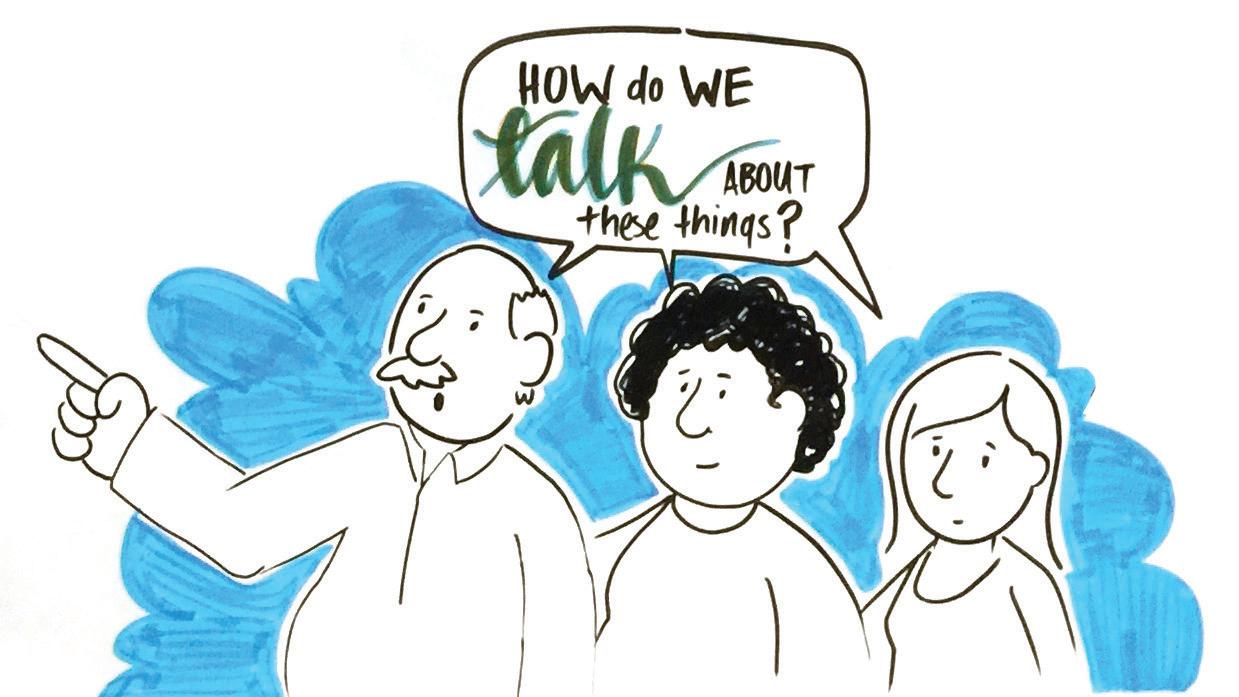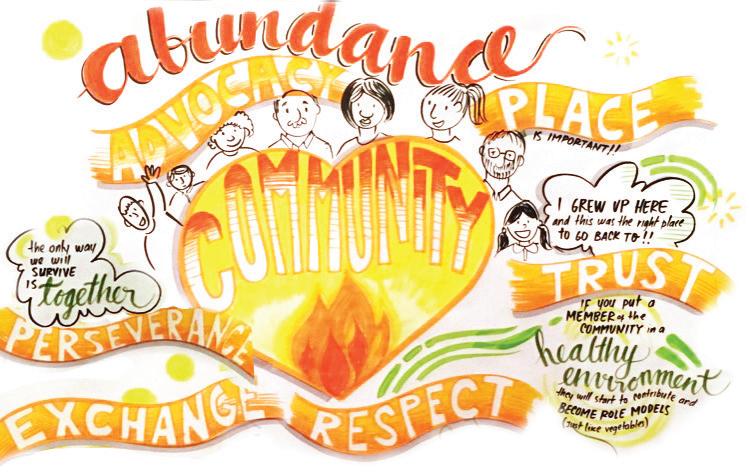
9 minute read
Our invitation
A small team from NewStories has been on an incredible journey in the first half of 2016. The goodwill and spirit and work of people across the United States have given us many insights and stories to share. The deep commitment of those on the Healthy Children Healthy Weight Team at the Robert Wood Johnson Foundation to discovering what it really takes to create a culture of health opens possibilities for new kinds of collaboration and partnerships. Our team -- Kate Seely, Simone Poutnik, Bob Stilger, Zulma Pattarroyo, and Erica Bota -- is honored to share some of what we’ve heard.
Our listening has taken us from the lush mountains of West Virginia to the majesty of the Pacific Coast, from the prairies of eastern Oklahoma to the sub-deserts of New Mexico. We’ve been fortunate to listen to literally thousands of people as they shared what they are doing to restore health, not to mention dignity, and the obstacles they encounter. These insights that ordinary people have about their health provide essential directions for creating a culture of health.
What we heard was rich and powerful and has resulted in a final report of many pages! We’ve written this report both to the Foundation and to the people who shared their stories and experience with us. Nothing hidden here. It is new partnerships between the Foundation and folks who are already stepping forward to make a difference which will move us as people, communities and a nation towards greater health.
We’re not going to try to summarize this report. It took a lot of time to listen and a lot of time to write. We invite you to spend time with it as well. If you can, we invite you to find a quiet couple of hours, with you beverage of choice, and just read from beginning to end. Note the questions and insights that come to you as you read. We’d love to talk with you further about what you see and feel.
That said, the simple summary is this. We spent time talking with and listening to people from all different walks of life.
Children, parents, and grandparents. Activists and community builders. Native Spanish speakers, Cherokee, black, and white folks. Individuals who experience generational poverty and adversity. Folks who are out of work. Folks who are trying to get ahead but can’t. These are the voices of people who matter. We listened. All across this country people, both ordinary people and those who are making a career out of this work, are taking responsibility for their health. They are partnering with each other to make a difference. We, collectively, know enough about what needs to be done. The orientation is shifting from believing that people are provided with good health by medical professionals towards a much more complex landscape that has many actors. It is time to invest in that landscape.
If you are unable to that quiet two hours with this report, let us describe some other ways to explore.
If you first want to find out more about how we approached this listening and where we went, skip to the end of the report and the Background section. It describes what NewStories and RWJF were aiming for as we began the project and highlights where we listened and how. This section also includes an array of photos from different sessions as well as the graphic recordings of our many community conversations.
The Healthy Kids Healthy Weight Team at RWJF shared some of the Key Questions with us that the team has been exploring. For the most part, they are quite different than the questions being asked at the community level. We kept these key questions in the back of our heads as we listened in community and found a number of insights and experiences to share. If you want to review what the Foundation has been asking, check out this section.
Most of us have ideas about How Change Happens. Those ideas influence what we see and hear. And, as we engage with others, our ideas grow. Our views on change undoubtedly influenced our listening and this short section of the report illuminates what we are seeing now. As you read this section, please notice how your own ideas about change are similar to and different from ours.
As we started to write this report, we became aware that a Culture of Health prospers in a particular Landscape. That’s really not surprising. Culture of anything is held by certain markers and attributes and characteristics. It’s too easy, however, to unintentionally use the term “culture of health” in a somewhat glib and superficial way -- almost relating to it as a series of desirable transactions. It is much, much more. A culture of health is a system and there are certain elements which support the development of that system. As you read this section, we invite you to note what else is present in this landscape for you. What is it, when tended, that is most likely to move us towards a culture of health?
In our listening, we wanted to know what people are actually doing -- how they are Taking Action. We’re often reminded of the wisdom of a colleague many years ago who rubbed a time between his fingers and said good ideas are a dime a dozen, it’s the one’s you do something about that count. In our listening we were interested in what people were already doing, in what was helping them and what was holding them back. In this section we look at some of the local practices which stood out for us. As you read this section, please note what questions come up for you about this collage of action.
Our listening was an exploration of new possibilities for Grantmaking and Community Engagement by RWJF. A core question we carried with us into each conversation was if the Foundation wants a Culture of Health to flourish in the US, what might it do? With the huge investments and high aspirations the Foundation has, how might it make even more of a difference. We realize that running RWJF is already a big job. Our question is about where arenas of new possibility and experimentation might be opened. How might RWJF engage in communities differently and watch what happens while at the same time attending to the ongoing business of running a major foundation?
We invite you into this report. Enjoy!
Our thanks
We must begin this report with our deepest gratitude to both the Healthy Children Healthy Weight team at the Robert Wood Johnson Foundation (RWJF), and to the people and communities we were welcomed into, whose stories we were privileged to hear.
It is no easy task to reorient a team of people, let alone a large, national health foundation, towards authentic community engagement. And yet, big steps have been taken. Part of the reason we were able to do this work on such a short timeline is because of the relationships and presence that the foundation already has established. Everywhere we went, we found traces of RWJF and the good work being supported. We heard stories of years-long partnerships and support. We heard of projects, grants, research, and individual staff, all of which has already done wonders to help people and communities across the U.S. Wherever we went, the trail led back to RWJF. We offer a deep thank you to you all for asking the hard questions that you are asking, and for entrusting us with a piece of this work. We hope we can help illuminate at least a part of the path forward. And our deepest gratitude to the people and the communities that we were welcomed into. You shared your truths, about your own lives, about what you believe needs to happen to build healthier people, healthier families, and healthier communities. We could never have expected the warm welcome that we received. For us, this has been the biggest gift of all -- to see how, in the face of generations of adversity, people continue to come together, to work towards something better, because it’s the only thing to do. And you continue to open your arms and doors to those of us from the outside to learn what it is you are doing, at the local level, to lift each other up. Our deepest thanks to you for the generosity in your sharing and your welcoming.
During the Spring of 2016, NewStories conducted a national listening tour in diverse communities in four states across the U.S., both to better understand the lived experience of marginalized families and to explore a model of community engagement.
While there have been gains in health in the U.S., there are also highly disturbing trends that directly affect health, such as childhood poverty rates, education gaps, and obesity rates. The answer might just lie in more community engagement. The Healthy Children Healthy Weight (HCHW) team is asking itself how to talk with and engage communities in a more consistent and effective way, and how to make this common practice within the foundation. The HCHW team is also wondering, largely, what are the policies, practices, and changes that will raise awareness and change the way people treat themselves and each other in communities.

On the brighter side of health in the U.S., there is an explosion of how we collectively understand how the mind and the body are connected. What we experience when we are young and how trauma affects us is much better understood today. Recognizing the intersectionality of issues as we build a culture of health offers both the challenge of confronting complex and interrelated problems, as well as the opportunity to ask ourselves new questions and see things in a new way.
RWJF is in the midst of a major strategy redesign process. “Emergent strategy” implores us to constantly sense and adapt to changing environments. As Kristin Schubert, Director of the HCHW team, stated in our opening meeting “In a sense, there is nothing new about this. We have always been doing this. We are in direct relationship with one another always. As living beings, we are constantly adapting to the context around us.” What this means as we work to build healthy communities, however, is that we are concerned with a systems challenge, one that looks not only at the conditions present around us, but the conditions we are a part of in our organizations as well.
We turned to people in four parts of the country: West Virginia, Eastern Oklahoma, New Mexico, and Northern California. We were in many, many circles, events, and conversations with thousands of people, listening for what they know about creating a culture of health. This is the work they do every day. These areas are profiled in the Background.
The recommendations and actions we propose in this report are as much about community change as they are about organizational change. It is not only about RWJ supporting community change external to the organization (both in the way you do your grantmaking and the way you consider your role in communities), but RWJ doing the work inside the organization to be a part of community change. As Kristen Schubert said in the beginning of this project: “We are in direct relationship with one another.” We are not separate from one another, and we must be in relationship with one another, even when it’s difficult. We are all a part of the systems that create and maintain inequities. If we truly want to remedy that, we must start with looking at ourselves.
One guiding question rose to the top as the aim for the listening tour. The goal has been to learn, directly from parents and caregivers, how the Robert Wood Johnson Foundation can engage families to support a culture of health. Additionally, this listening tour sought to answer the questions: What is the living experience for all families, especially marginalized ones? What do marginalized families need to thrive? And finally, what issues are important to families in need?
The final section of this report, Background, reviews how we envisioned this project and what NewStories, together with RWJF, saw as indicators of success. The bottom line, really, was that none of us wanted another report that would get lost on an electronic shelf somewhere. We wanted to find the starting points for a new community engagement strategy to build a culture of health that will hopefully lead to further exploration and engagement.
Our engagement process is detailed towards the end of the report, however, to summarize, we:
1. Chose locations, beginning with 10 and whittling it down to four based on the short timeline of the project.
2. Conducted outreach, starting with our personal and professional contacts.
3. Held one-on-one meetings with individuals in a first inperson visit to each region
4. Convened conversations and listened in to conversations or events that were already planned.
5. Made sense of what we had learned, wrote this report, and will soon share it back with the communities themselves.

We humbly and wholeheartedly submit these learnings to you with the hopes that we can at least partially transmit the wealth of learning we experienced, the privilege that we felt in seeing such incredible people working towards a culture of health, and the wisdom that comes directly from communities themselves. As we heard time and again, “We know what needs to happen to change our community.”





